Last Updated on March 12, 2024
Ever tried making wild violet tincture? Tincturing medicinal plants is an easy way to preserve beneficial herbs like wild violets. Here’s what to know about how to make violet tincture and why it’s worth trying out.
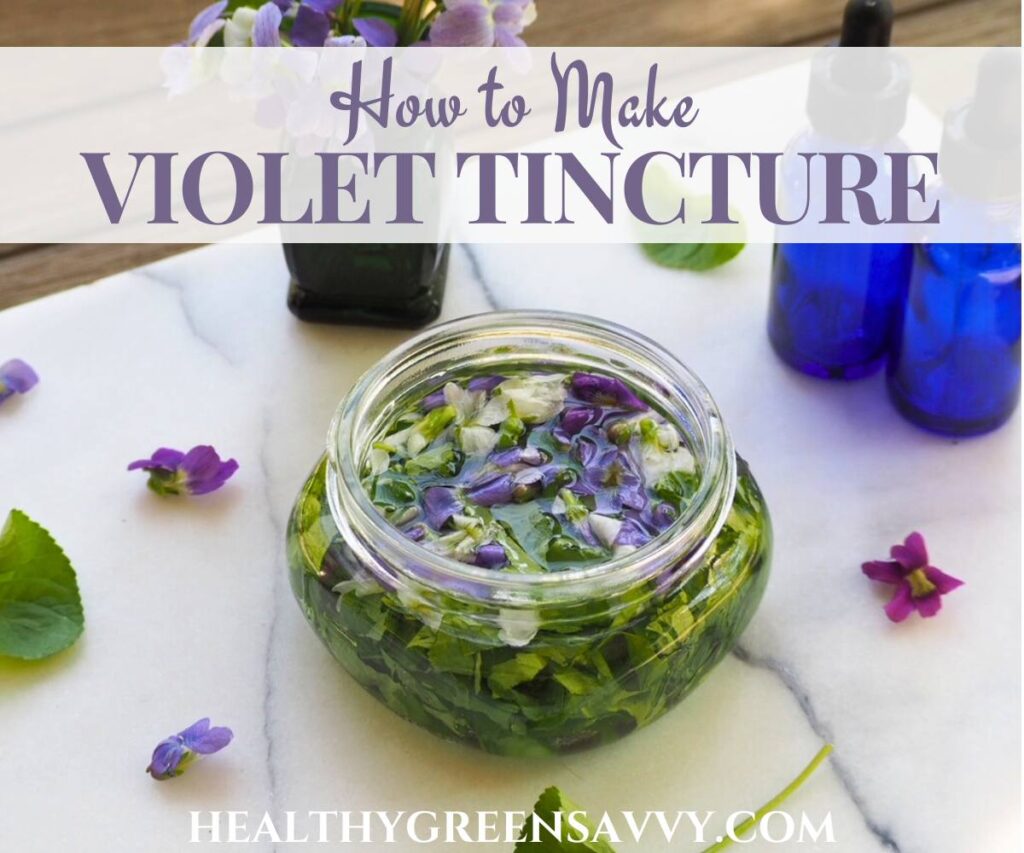
Made from the leaves and flowers of the violet plant (Viola spp.), violet tincture is a useful homemade medicine to have on hand.
Making your own violet tincture at home is a simple process that requires just a few ingredients and supplies. In this blog post, we will discuss the steps involved in making violet tincture, as well as some tips and precautions to consider.
WHY MAKE VIOLET TINCTURE?
Most people don’t realize that wild violets are an excellent herbal remedy for addressing inflammation, promoting digestion, and relieving respiratory conditions. One of the best herbs for cough, violets are likely growing in your garden already.
Note that since violet’s mucilage — the slippery substance that makes violet leaves useful for coughs — doesn’t extract well in alcohol, if that’s what you’re after, you’re better off with wild violet tea or syrup.
But today, we’re extracting other valuable medicinal compounds from violets with alcohol, which they’ll steep in for several weeks before we strain them out and bottle up our violet tincture.
The benefits of violet tincture include
- Supporting the lymphatic system
- Reducing inflammation
- Relieving pain
- Soothing coughs and irritated tissues
- Promoting sleep
Violets contain compounds that have been used medicinally for centuries. Modern research supports these traditional uses for violets. Find additional details about the medicinal uses of wild violets at Herbal Academy.
The tincturing process extracts and concentrates the plant’s medicinal compounds into an easy-to-take liquid that you can keep on hand until you need it.

UNDERSTANDING TINCTURES
Tinctures are simply herbal extracts made by letting an herb steep in alcohol for several weeks. As long as you know what type of solvent to use and the right ratio of plant material to solvent, you can make homemade tinctures easily.
Different solvents extract different compounds from plants. Some plants work well steeped in hot water (to make tea), while herbalists prefer others steeped in alcohol to make tincture. Sometimes herbs are steeped in vinegar to make herbal vinegar or in glycerin to make what’s called a glycerite. Sometimes oils or honey are used.
As the Herbal Academy explains,
Using a solvent like alcohol, vinegar, or glycerin, you can extract a greater spectrum of the whole plant and preserve the medicine much longer than an infusion or a decoction. Alcohol is especially an excellent solvent that extracts a wide range of plant properties and allows for easy absorption of healing compounds into the bloodstream.
Violet tincture is made by steeping violets in high-proof alcohol for about a month to extract its beneficial compounds.
If you’d prefer to avoid alcohol, follow the instructions below but use vinegar or glycerin in place of alcohol. They’ll extract slightly differently, but you’ll still get a useful violet extract.

Home herbalists commonly use what’s known as the “folk method” when making tinctures, using rough measurements to produce tinctures with more variable concentrations. If you’d rather be more precise and consistent, use the “weight to volume” method.
FORAGING WILD VIOLETS
Anytime you forage a plant for the first time, you should make sure to positively identify it using multiple features of the plant.
–> Always consult a good field guide or go with an experienced forager to ensure you’ve correctly identified any plant you’re foraging.
Also do your research into which parts of the plants are safe to consume. While all parts of some plants are safe to eat, others have both edible and poisonous parts, like elderberry.
We use only the flowers and leaves from wild violets. Violet roots and seeds are poisonous.
One of my all-time favorite foraging experts, Sam Thayer, released a new guide last spring, and it’s a must-have for foragers at all levels of experience. I’ve consulted his three previous books often for their thorough plant descriptions and entertaining writeups, and I was thrilled when I saw he’d come out with a guide putting all his decades of plant knowledge in one massive book, covering 679 species, nearly double what you’ll find in the Peterson Guide. You can order your own copy here.
I’ve got more details about the best foraging books available as well as my top suggestions for the best herbalism books to keep on hand to deepen your study of herbs.
Taking a foraging course can help you to hone your skills further. The Herbal Academy’s online foraging course covers plant identification and will help you feel more confident foraging all sorts of useful medicinal plants. They also have numerous herbalism courses worth checking out.
WHICH TYPE OF VIOLETS CAN YOU USE TO MAKE VIOLET TINCTURE?
You can use most common wild violets for tincture. Viola odorata, or sweet violet, is native to Europe and is generally the one called for in herbal medicine. In North America you’ll likely find Viola sororia, which herbalists use in the same ways.
Rico Cech notes that Viola tricolor (or heartsease) may also be used but it’s more gentle in its action.
African violets (Streptocarpus ssp.) are not true violets and should not be consumed. Here are some other look alikes to be aware of if you’re foraging violets.
HOW TO MAKE VIOLET TINCTURE
Ready to make some wild violet tincture? Here’s how.

SUPPLIES YOU’LL NEED
- Wild violet leaves and flowers (harvested after positively identifying)
- Glass jar
- Fine mesh sieve
- Funnel
- High proof alcohol (minimum 40%, or 80 proof, but higher is preferred), typically vodka, though you can also use grain alcohol; alternatively, use food-grade glycerin or vinegar if you don’t want to use alcohol
- Amber or blue bottles with droppers (like these or these)
- Cheesecloth can help strain out any tiny pieces of plant material, making a longer-lasting finished product
I generally use organic vodka made by a local distiller. A large bottle of vodka will last a long time when you’re making small batches of herbal tincture, and organic vodka will be cleaner than a non-organic brand. But if you can’t find organic alcohol, I wouldn’t worry about it. We’re taking very small amounts when we use tinctures.
Most vodka you’ll find in stores is 80-proof. Many herbalists recommend higher-proof alcohol when tincturing fresh herbs, so if you use 80-proof alcohol, be sure to let your violets dry some before tincturing.
I move washed leaves to dry towels several times, and after I chop them, I allow the moisture released by chopping to evaporate a little while before putting it in my jar. They’ll be significantly less moist just a half hour later.
–>Do not use rubbing alcohol (isopropyl alcohol), which should never be taken internally.
If you want to know more about the details of choosing a solvent, I highly recommend this article.
INSTRUCTIONS
1. Rinse wild violet leaves and flowers to remove dirt or insects. Allow them to dry on a clean kitchen towel. A salad spinner can help remove excess water more quickly.
2. When violets are fully dry, chop them into very small pieces to expose as much surface area as possible.
3. Place chopped violets in a clean, dry jar. Do not pack them in tightly. If using fresh violets, fill about 2/3 full; if using dried violets, fill only half full because the herbs will expand as they absorb liquid.
4. Cover completely with alcohol (or vinegar or glycerin) to an inch above the herb.
5. Cover the jar and seal it tightly. Give it a shake and allow herbs to settle for about an hour. Add more liquid if necessary to cover the herbs completely, seal and shake again.
6. Place your jar in a cupboard for 4 to 6 weeks, shaking gently every day or two. Make sure plant material is completely submerged.
Write the end date on a calendar or set a reminder on your phone to help you remember to strain your finished tincture.
7. After 4 to 6 weeks, it’s time to decant your tincture. Place layers of cheesecloth inside a sieve and strain the infused alcohol into a bowl.
8. Squeeze the cheesecloth to remove as much liquid as possible and discard the plant material.
9. Allow your tincture to settle for about 24 hours. If it looks like some plant material remains, strain again using a coffee filter to remove it.
10. Fill tincture bottles using a funnel. Remember to label with the contents and the date.
Notes: Mid morning is a preferred time for collecting herbs, after the dew has evaporated.
HOW TO USE VIOLET TINCTURE
Guidelines for using tinctures can vary quite a bit. You’ll often see an entire dropperful of tincture several times per day recommended, while some herbalists prefer using three drops placed under the tongue.
Rico Cech, author of Making Plant Medicine, advises taking tinctures between meals to maximize their absorption. He writes that smaller bodies generally require less herb than larger ones, and that those with acute conditions should take herbs more frequently than people with chronic ones.
Consult a qualified herbal professional for specifics of using violet tincture.
CAUTIONS
Herbs can interact with certain medications and conditions. Always talk to your doctor before trying new herbs.
TINCTURE FAQS
CAN I USE DRIED VIOLETS INSTEAD OF FRESH?
Yes. As mentioned above, fresh herbs are often preferred, but you can also use dried violet leaves and flowers. You’ll use about half as much herb when you use dried rather than fresh.
CAN I STILL MAKE VIOLET TINCTURE WITHOUT ALCOHOL?
Yes! Though technically not a tincture, you can make a violet extract using glycerin or vinegar, as described above.
WHAT SIZE JAR SHOULD I USE?
You can use any size jar you like, as what’s important is the ratio of plant material to solvent. But do give some thought to how much violet tincture you might realistically want in the next few years. When I’m making a tincture I use regularly, like elderberry, I’ll use a pint jar. For something I use less often, I’ll use a half-pint jar. I generally follow the three drops under the tongue guideline, so even a small bottle of tincture lasts awhile.
HOW LONG DOES VIOLET TINCTURE KEEP?
Alcohol-based tinctures stored in a cool, dark place keep for many years.
You can read more about the shelf life of herbal preparations in this post from Herbal Academy.
I FORGOT TO STRAIN MY TINCTURE! IS IT STILL ANY GOOD?
Though you’ll generally see instructions for homemade tinctures suggesting a 4- to 6-week timeframe, I’ve heard many herbalists say they’ve left their tinctures unstrained for months and it’s been fine. If the herbs weren’t fully submerged, though, they may have grown mold and you’ll need to toss it. Inspect your tincture carefully.
WHAT CAN I USE LEFTOVER ALCOHOL FOR?
You could of course at it to cocktails, or just keep it on hand for making more tinctures with other useful herbs. A single bottle of vodka has yielded me many herbal medicines I turn to throughout the year, including pine needle tincture, goldenrod tincture, stinging nettle tincture, elderberry tincture, elderflower tincture, lemon balm tincture, California poppy tincture, and ground ivy tincture. It’s so helpful to have these on hand during the six months that nothing grows here.
If you’d like to expand your herbal knowledge, consider adding some of the best herbal medicine books to your home library.
Have you tried using violets medicinally? They’re also a great edible wild plant to work with. Check out our collection of more than 25 wild violet recipes you can try this season.
Other medicinal plants & preparations to explore:
- Cleavers Plant Uses
- Identifying & Using Goldenrod
- Chickweed Identification & Uses
- Growing a Medicinal Herb Garden
- How to Make Pine Needle Tea
Save this violet tincture recipe for later!

Disclaimer: I’m a health enthusiast, not a medical professional. Content on this website is intended for informational purposes only and is not meant to provide personalized medical advice. I draw on numerous health sources, some of which are linked above. Please consult them for more information and a licensed professional for personalized recommendations.
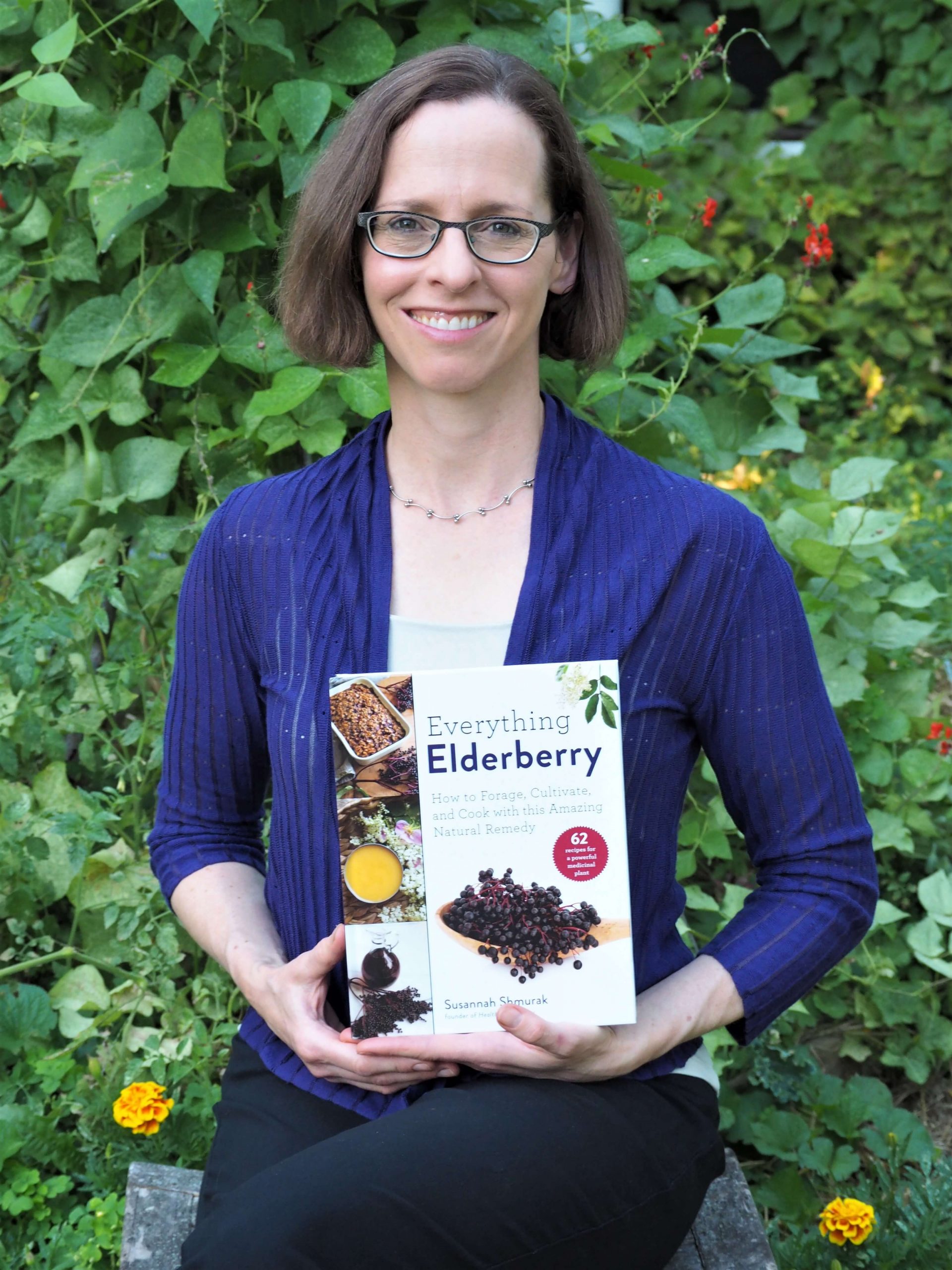
Susannah is a proud garden geek and energy nerd who loves healthy food and natural remedies. Her work has appeared in Mother Earth Living, Ensia, Northern Gardener, Sierra, and on numerous websites. Her first book, Everything Elderberry, released in September 2020 and has been a #1 new release in holistic medicine, naturopathy, herb gardening, and other categories. Find out more and grab your copy here.



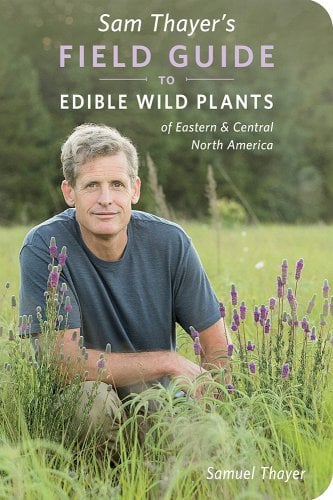
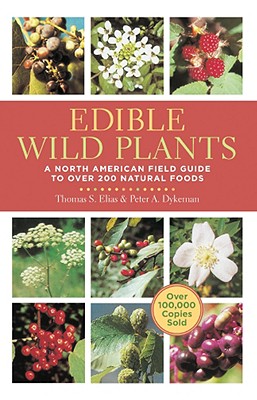
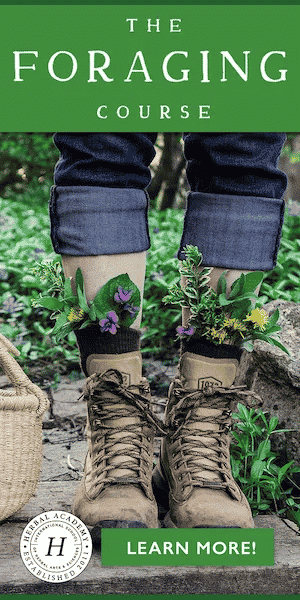
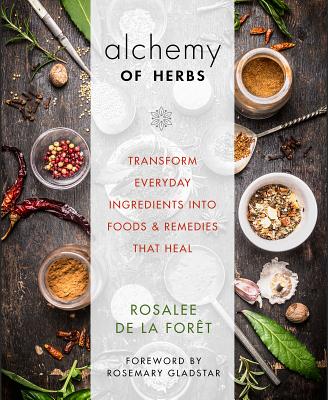
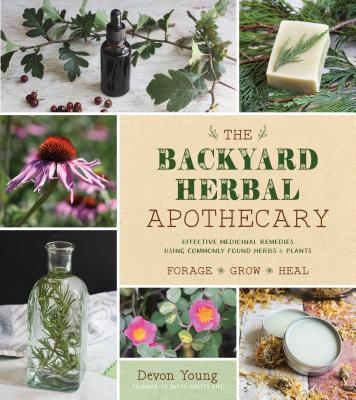

 Hi, I'm Susannah, a garden geek, energy nerd, and fan of healthy food and natural remedies. Need some simple, practical solutions for living healthier and greener? You've come to the right place! More about me and my green projects
Hi, I'm Susannah, a garden geek, energy nerd, and fan of healthy food and natural remedies. Need some simple, practical solutions for living healthier and greener? You've come to the right place! More about me and my green projects
Leave a Reply